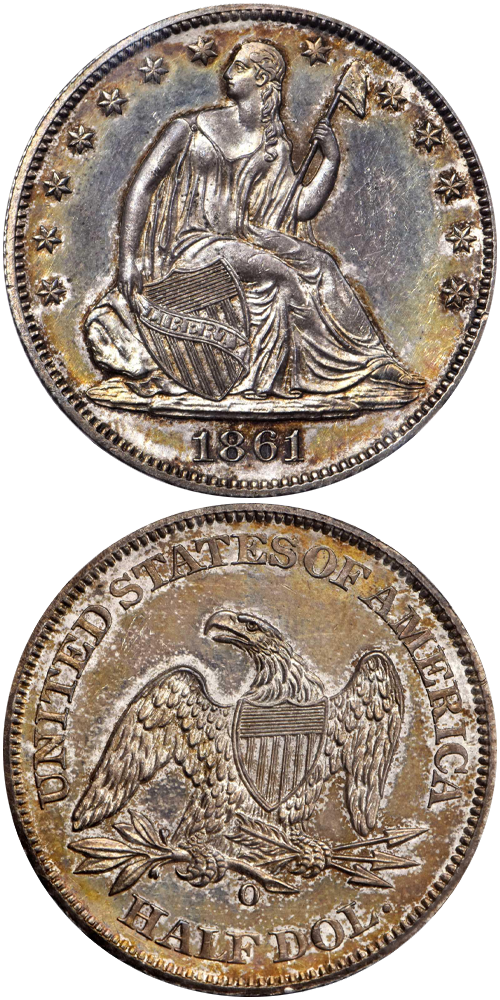1861-O Liberty Seated Half Dollar
Louisiana Issue
Branch Mint Proofs: The story of this unusual coin begins with Louisiana's secession from the Union on January 26, 1861. The New Orleans Mint was seized by state forces on January 31, the Secession Convention having adopted an ordinance two days earlier that provided for Federal employees to continue in their posts as employees of the State of Louisiana. Soon thereafter control of the Mint was transferred to the Confederate States of America, the previous Federal employees once again remaining in their posts by swearing an oath of allegiance to the Confederacy. The officials were William A. Elmore, Superintendent; A. J. Guirot, Treasurer; Howard Millspaugh, Assayer; Dr. B. F. Taylor, Chief Coiner; M. F. Bonzano, M. D., melter and refiner. According to Chief Coiner Benjamin F. Taylor in a letter written after the Civil War, "...[The New Orleans Mint] was turned over by the State of Louisiana, the last of February, 1861, to the Confederate States of America..." (quoted in Gold Coins of the New Orleans Mint: 1839-1909, 2018 edition, by Douglas A. Winter). It was not until April 1, 1861, however, that the Southern Confederacy actually took possession of the Mint building.
Rewinding the clocks to January, half dollar production at the New Orleans Mint for calendar year 1861 had begun under normal circumstances, the facility producing 330,000 coins that month under the auspices of the United States of America. Coinage continued after Louisiana's secession from the Union, again from Federal 1861-O dies, with the Mint delivering 1,240,000 additional half dollars under state authority. This coinage was achieved during February and March, in other words during the two months between the State of Louisiana's seizure of the Mint on January 31 and the Confederate States of America taking possession of the Mint building on April 1. The Southern Confederacy proceeded to strike an additional 962,633 half dollars, again using Federal 1861-O dies, during the month of April, at the end of which the bullion supply had become exhausted and coinage operations ceased.
In April 1861, Confederate Treasury Secretary Christopher G. Memminger requested designs for a Confederate half dollar. Since any special (read: Specimen or Branch Mint Proof) strikings of half dollars for the Confederacy would undoubtedly have used the newly approved dies -- with the appropriate Confederate States of America legend and designs -- special strikings of the 1861-O half dollar must have been prepared to commemorate a significant event prior to the New Orleans Mint passing under Confederate control. That event was almost certainly the acquisition of the Mint building by the State of Louisiana on January 31. Indeed, the die pairing from which the present specimen was struck, W-04, is one of the varieties of the 1861-O half dollar issue that Bill Bugert attributes to the State of Louisiana in his excellent reference A Register of Liberty Seated Half Dollar Varieties, Volume IV: New Orleans Branch Mint, 1853-O NA to 1861-O (2013). The famous Robert LeNeve specimen displayed at the New Orleans Mint is also from the W-04 dies. We can conclude, therefore, that a limited number of Specimen or Branch Mint Proof 1861-O half dollars were struck under the authority of the State of Louisiana in February or March of 1861, likely the former month, and shortly after control of the Mint was assumed by the state.
All Specimen or Branch Mint Proof coins are rare regardless of the facility in which they were struck or for what purposes, and the 1861-O Liberty Seated half dollar is no exception. In his Encyclopedia of United States and Colonial Proof Coins: 1722-1989, Walter Breen lists six specimens for the overall issue, two of which may be duplicates. We believe that only four or five different Specimen or Branch Mint Proof 1861-O half dollars can be accounted for currently.
The example to the left was sold by Stack's Bowers Galleries in the November 2019 Baltimore Auction, where it realized $66,000.






